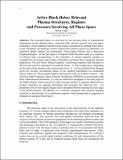| dc.contributor.author | Coppi, Bruno | |
| dc.date.accessioned | 2012-07-26T13:37:57Z | |
| dc.date.available | 2012-07-26T13:37:57Z | |
| dc.date.issued | 2011-03 | |
| dc.date.submitted | 2010-08 | |
| dc.identifier.issn | 1070-664X | |
| dc.identifier.issn | 1089-7674 | |
| dc.identifier.uri | http://hdl.handle.net/1721.1/71829 | |
| dc.description.abstract | The presented theory is motivated by the growing body of experimental information on the characteristics, connected with relevant spectral, time, and space resolutions, of the radiation emission from objects considered as rotating black holes. In the immediate surroundings of these objects, three plasma regions are identified: an innermost Buffer Region, an intermediate Three-regime Region, and a Structured Peripheral Region. In the last region, a Composite Disk Structure made of a sequence of plasma rings corresponding to the formation of closed magnetic surfaces is considered to be present and to allow intermittent accretion flows along the relevant separatrices. The nonlinear “Master Equation” describing composite disk structures is derived and solved in appropriate asymptotic limits. A ring configuration, depending on the state of the plasma at the microscopic level: (i) can be excluded from forming given the strongly nonthermal nature of the electron distribution (in momentum space) within the Three-regime Region allowing the onset of a spiral structure; the observed High Frequency Quasi Periodic Oscillations are associated with these tridimensional structures; (ii) may be allowed to propagate to the outer edge of the Buffer Region where successive rings carrying currents in opposite directions are ejected vertically (in opposite directions) and originate the observed jets; or (iii) penetrates in the Three-regime Region and is dissipated before reaching the outer edge of the Buffer Region. The absence of a coherent composite disk structure guiding accretion in the presence of a significant magnetic field background is suggested to characterize quiescent black holes. | en_US |
| dc.description.sponsorship | United States. Dept. of Energy | en_US |
| dc.language.iso | en_US | |
| dc.publisher | American Institute of Physics (AIP) | en_US |
| dc.relation.isversionof | http://dx.doi.org/10.1063/1.3562572 | en_US |
| dc.rights | Creative Commons Attribution-Noncommercial-Share Alike 3.0 | en_US |
| dc.rights.uri | http://creativecommons.org/licenses/by-nc-sa/3.0/ | en_US |
| dc.source | Prof. Coppi via Mat Willmott | en_US |
| dc.title | Active black holes: Relevant plasma structures, regimes and processes involving all phase space | en_US |
| dc.type | Article | en_US |
| dc.identifier.citation | Coppi, Bruno. “Active black holes: Relevant plasma structures, regimes and processes involving all phase space.” Physics of Plasmas 18.3 (2011): 032901. | en_US |
| dc.contributor.department | Massachusetts Institute of Technology. Department of Physics | en_US |
| dc.contributor.approver | Coppi, Bruno | |
| dc.contributor.mitauthor | Coppi, Bruno | |
| dc.relation.journal | Physics of Plasmas | en_US |
| dc.eprint.version | Author's final manuscript | en_US |
| dc.type.uri | http://purl.org/eprint/type/JournalArticle | en_US |
| eprint.status | http://purl.org/eprint/status/PeerReviewed | en_US |
| dspace.orderedauthors | Coppi, Bruno | en |
| dc.identifier.orcid | https://orcid.org/0000-0002-4920-8617 | |
| mit.license | OPEN_ACCESS_POLICY | en_US |
| mit.metadata.status | Complete | |
